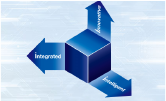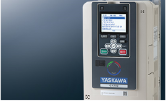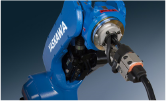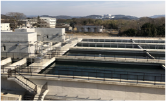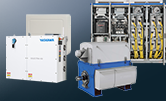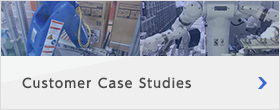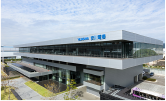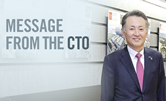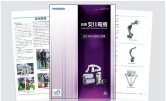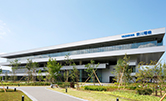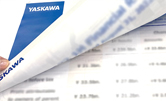|
1. Selected Financial Data for the First Half of the Fiscal Year ending March 20,2004
All Figures in Millions of Yen, Except Per Share and Ratio Data
| Summary of Consolidated Income Statement |
| |
1st Half FY2003 |
1st Half FY2002 |
| Net sales |
117,091 |
97,920 |
| Net operating income (loss) |
1,907 |
(2,891) |
| Ordinary income (loss) |
1,365 |
(4,383) |
| Net income (loss) |
(557) |
(6,850) |
| |
|
|
| Net income (loss) per share (Yen) |
(2.41) |
(29.52) |
| Summary of Consolidated Balance Sheets |
| |
1st Half FY2003 |
1st Half FY2002 |
| Total assets |
233,349 |
231,628 |
| Shareholders’ equity |
31,173 |
27,314 |
| Shareholders’ equity ratio |
13.4% |
11.8% |
| |
|
|
| Shareholders’ equity per share (Yen) |
134.69 |
117.72 |
| Summary of Statements of Cash Flows |
| |
1st Half FY2003 |
1st Half FY2002 |
| Net cash (used in) provided by operating activities |
6,821 |
3,900 |
| Net cash (used in) provided by investing activities |
(2,125) |
(2,652) |
| Net cash (used in) provided by financing activities |
(7,051) |
361 |
| Cash and cash equivalent at the end of year |
14,096 |
17,688 |
2. Management Policies
Fundamental Management Policy
YASKAWA Electric Corporation, along with its subsidiaries and affiliated companies, has long held to the principle of “Advancement of Society and Contribution to Humanity through the Promotion of Business”. The supporting principles of “Developing State-of-Art Technology with a Mind for Quality” and “Responding to the Market according to Consumer Trends and Needs” have been joined by an “Investor Focused” view of value creation.
As a result, YASKAWA has taken on the improvement of capital efficiency as our number one priority. In order to make this possible, CS (Customer Satisfaction) will be improved through products and services that greatly satisfy our customers. As a result of ES (Employee Satisfaction) improvement activities, our employees will feel YASKAWA is a company worth working for. These two main activities will result in higher corporate value, greater earnings power, and the restoration of shareholder value to our investors
Dividend Policy
It is our intention to provide a stable and continuing dividend to our shareholders. We will manage our company with our financial goals, financial conditions and the economic environment in mind in order to achieve this.
Policy on Reduction of Share Trading Unit Size
The amendments to the Japanese Commercial Code that took effect in October 2001 allows listed companies to reduce the number of shares per unit for trading (“share trading unit”) on stock markets in Japan. Among our reasons for not availing ourselves of this change in the regulation, is our belief that YASKAWA’s current liquidity is sufficient. Also, in consideration of our current share price along with the additional costs related to reducing the share trading units of stock, we do not feel that it would create value for the company or our shareholders. We will continue to monitor stock market trends and make any decisions related to this change in the Commercial Code based upon the value to our stockholders.
Management Targets
To ensure our shareholders’, employees’, and other stakeholders’ value is maintained, our management performance is evaluated by 2 main ratios: ROE and the Debt-to-Equity Ratio.
We believe it is necessary for us to realize the maximum earnings possible for a high return on our shareholders’ invested capital. Also, we believe we should maximize earnings for all our stakeholders, including our employees, along with the investors.
Furthermore, it is our purpose to make YASKAWA’s corporate structure such that it will remain profitable even in the midst of difficult economic times. In order to accomplish this goal, we aim to increase the profit ratio of the company, and to improve the trust of those individuals and entities that provide capital to the company.
Mid- and Long- Term Business Strategy
YASKAWA’s new 3-year (2003 – 2005) business plan, “Win21 Plus”, builds and expands on the four structural reforms, Business, Corporate, Management and Financial, of the past mid-term plan “Win21”. Additionally, through the actions of “Win21 Plus” YASKAWA plans to achieve the original financial targets of the previous mid-term plan, which were not achievable due to the harsh economic environment of the past few years. The new mid-term plan also aims to strengthen YASKAWA’s competitiveness and realize greater business process efficiency.
Win21 Plus Strategies
YASKAWA will promote real structural change in the finance and business areas relating to the post-mechatronics shift. The company will also promote a policy toward implementation and execution that will build on the systematic reforms of “Win21” in the corporate and management areas. By reinforcing these changes through cross-functional activities, YASKAWA will create a new cost model, link market strategy and innovation, and create a new business model, which are all goals of “Win21 Plus”. At the same time YASKAWA will transform its corporate structure into one capable of maintaining profitability in the face of up to 30% change in demand.
Win21 Plus Goals
1. Double value-added productivity
2. Ordinary Profit Ratio of 10%
3. D/E Ratio of 1.0 or less
Win21 Plus Financial Targets
| |
2005 Forecast (cons.) |
2005 Forecast (uncons.) |
| Revenues (million yen) |
300,000 |
160,000 |
| Ordinary Profits (million yen) |
30,000 |
16,000 |
| Ordinary Profit Ratio (%) |
10.00 |
10.00 |
| Beginning Employee Count |
7,450 |
2,600 |
Management Initiatives and Challenges
As we execute the many initiatives of “Win21 Plus”, our group will reinforce its competitive position and transform itself into a high-earnings company.
Specifically, the second half of 2003 will be a continuation of the cost structure improvements and balance sheet reforms that were given priority during the first half of this fiscal year.
In order to realize the cost structure reforms, YASKAWA is developing products that have greater value-added features and greater cost competitiveness. In addition to increasing these products’ time-to-market, YASKAWA is strengthening its sales capabilities thereby improving the earnings potential of a single product in various ways. The centralization of procurement for the group, better supplier relationships, and expansion of overseas suppliers have improved YASKAWA’s material and parts cost reduction. Furthermore, the improvement in productivity realized through our group’s manufacturing company as well as expansion of manufacturing to overseas locations will radically decrease manufacturing related costs.
In the area of Balance Sheet reforms, the reduction of inventory is being intensified through the improved order forecasting abilities of an ERP/SCM system. Through this system YASKAWA will be able to control its daily inventory on a far more detailed level than we currently are capable of today. Continued improvements in the way in which our group plans deliveries will further enforce our cost reduction policies.
In other areas, market strategies that promote market share increases and maximization of business opportunities are activities relating to the preparation and enhancement of our organization to serve the expected growth of the Chinese Market.
Additionally, through advances in our technologies, differentiable products and solutions are being created to better serve our customers, which in turn enhances our competitive position. The expansion and opening of new markets and new businesses are also part of YASKAWA’s “Win21 Plus” goals.
Governance Policy and Actions
Our Basic Premise on Governance
We believe increasing shareholder value based upon plans for developing a healthy business, managerial decision making which quickly meets an ever-changing society, and in accordance with the law, is an extremely important goal.
In order to accomplish this goal, YASKAWA will enrich its corporate governance in accordance with the law as we strengthen, improve and prepare the functional system of our current shareholders’ meeting, board of directors, auditors, and certified public accountants. Simultaneously, we plan to structurally improve our relationships starting with our stockholders and customers, as well as with clients, local society, and our employees.
Furthermore, we will provide our shareholders and other capital providers with both speedy and accurate information as well as a breadth of information, thereby increasing the transparency of our company’s management.
Governance Status and Actions
Oversight of managerial decision-making, execution as well as assessment is being handled through the adoption of an auditing system. Whether it be our investors, customers or any other entity familiar with our company it will be evident that YASKAWA is complying with the law through the adoption of one outside director and two outside auditors. Furthermore, neither our company nor our outside directors and auditors are interested parties in either financing or trading relationships with YASKAWA.
The Board of Directors will hold meetings approximately once a month. Special Board of Directors meetings will be held when warranted by law or the materiality of the issue to the management of the company or when the execution of certain business conditions requires specific supervision by the shareholders/directors.
Our audit firm is Shin Nihon. As part of the contract for auditing services we are required to provide accurate management information. The auditors provide an open and impartial point of view and environment. In any situation where the auditors’ judgment is necessary YASKAWA will consult with the auditors to receive the necessary support.
In regard to legal counsel, whenever YASKAWA finds it necessary to consult with a legal advisor and receive the proper advice we take necessary actions to do so.
Internally, the Company has set up an Ethics Committee whose job it is to ensure our Corporate Code of Conduct is being met in all our activities. In regard to our business standards, YASKAWA has both a “Company Credo” as well as the “YASKAWA Electric Corporate Conduct Standards”. The “YASKAWA Electric Corporate Conduct Standards” are maintained and clarification is provided to employees through our compliance program, which has been set up and promoted throughout the group by our President who was named as Chairman of the Corporate Ethics Committee.
This past fiscal year we fully implemented our corporate governance program. During the last fiscal year, the Board of Directors met 12 times, including extraordinary meetings, to handle materially important business items, items required by law, as well as to execute business decisions. Also, as a part of our Investor Relations program YASKAWA held 2 analyst meetings to present the results of fiscal year 2001 and the first half of fiscal year 2002.
Through the first half of this year, the Board of Directors met 5 times in total. One analyst meeting, presenting the results of fiscal year 2002, was also held.
3. FY2003 1st Half Business Performance
The Japanese economy, during this first half of 2003, showed both promise as well as remaining signs of difficulty. While the economy experienced steady exports and improved corporate performance as a result of recovery in the capital investment sector, deflation continued to plague the market while personal consumption continued to be weak. Overall, the Japanese economy failed to make a recovery.
In the international economy, while Europe continued to experience an economic downturn, from China throughout most of Asia the outbreak of SARS (Severe Acute Respiratory Syndrome) affected the region negatively but overall the area maintained a firm economic outlook. The United States, which continued to experience a downturn in its labor market, managed to come out of its economic decline mainly due to the upward trend in personal consumption.
In the midst of this economic environment, YASKAWA began its new mid-term plan “Win21 Plus” for a transformation into a high-earnings corporation, to be completed by 2005. In this fiscal year, in accord with the goal of becoming a high-earnings company, two objectives relating to the core strategy of creating a new cost model along with reforms in the balance sheet structure were put forward.
First, in addition to current activities aimed at realizing a new cost model, such as cost reductions in current products, new low-cost products’ speed-to-market was increased and sales volume was increased. Also, productivity increases and increased ability to handle manufacturing fluctuations resulting from the establishment of manufacturing companies within the YASKAWA group the previous year were complemented by increased production in China and greater utilization of local manufacturing. Furthermore, increased effectiveness from business process improvements and right-sizing the workforce led to decreases in indirect overhead costs.
In regard to the balance sheet reform, as orders increased, the utilization of the ERP/SCM system made it possible to decrease inventory and, along with the effects of better turnover of trade receivables, greater asset efficiency was achieved. Moreover, the sale of some assets provided the liquidity necessary to decrease interest-incurring debt.
The results of this first half were largely due to the focused effort on increased orders from high-growth markets such as the semiconductor, LCD, automotive-related markets and the Chinese market. In particular, the LCD related and automotive-related markets generated high results. Revenues for this period increased over the same period last year by 19.6%, ending at 117,091 million yen.
The ordinary profit for this period also increased 5,748 million yen over the same period last year, for a dramatic increase to positive 1,365 million yen. The net loss for this interim period was 557 million yen, an increase of 6,293 million yen over the loss incurred in the same period of the previous year.
4. Results by Business Segment
Beginning with this interim period (FY2003 first half), YASKAWA will begin reporting the information technologies business segment as a strategic business unit of the company. Therefore, information technology related business will hereafter be separately reported from the “other business segments”. YASKAWA’s reportable business segments now number five [5]: Motion Control SBU; Robotics Automation SBU; Systems Engineering SBU; Information Technologies SBU, and Other Business Segments
Motion Control SBU
In this segment, the AC Servo Motor sales associated with the LCD, machine tool, metal cutting, and injection-molding machine related markets stayed steady through this period. Sales to the electronic components markets also experienced an increase.
AC Drive sales also continued to be strong as capital investments in China increased exports. Also, to strengthen and expand sales in Europe, YASKAWA formed a joint venture with Omron this past April.
Revenues for this segment increased over the same period last year by 27.5%, ending at 49,637 million yen. Operating profits also increased over the same period last year by 3,490 million yen, improving to 1,688 million yen for the first half of 2003.
Robotics Automation SBU
The automotive-related markets in Europe experienced large increases in the use of spot welding products. Transfer robots to meet the needs of LCD production lines to meet the increasing size of LCD panels, increases in demand for notebook computers and LCD television screens also affected a positive trend in orders. Also, the Robotics Automation group successfully introduced new robots in July to meet the increasing demands placed on robotic functionality by the marketplace, such as improved quality of the production line, increased productivity support, optimum robotics for welding and handling.
In order to meet the expected recovery in demand for clean and vacuum robots for the semiconductor manufacturing equipment, YASKAWA worked in conjunction with current customers to develop new robots and expanded its customer base as a result.
Revenues for the Robotics Automation SBU increased 27.3% over the same period last year to 37,417 million yen. Operating Profits also increased 1,624 million yen to 1,702 million yen.
Systems Engineering SBU
The Systems Engineering SBU was able to take full advantage of the increase demand for renewal of capital equipment in wastewater process automation systems and in steel plants. In an effort to increase its presence in new markets, this SBU also focused on sales of high-voltage AC Drives, compressor systems and elevator related electronics. As a result, revenues increased over the same period last year by 3.4% to 13,237 million yen. Operating Profits ended at a negative 1,912 million yen.
Information Technologies
Limits on investments in IT and the harsher competitive climate brought on by demands for lower cost in the information services industry continued through the period. In the computer peripherals industry as well tough competition brought on a trend of declining prices. As a result of these conditions, this segment experienced a 2.8% decrease in revenues compared with the same period last year, ending at 11,312 million yen. Operating profits stood at 328 million yen at the end of this first half.
Other Business Segments
Revenues related to other business segments increased from the same period last year by 6.2%, ending at 5,487 million yen. Operating Profits were 310 million yen for this period.
5. Balance Sheet Highlights
Assets
Current Assets experienced an increase in Other Assets of 2,227 million yen over the previous period, but both Notes and Accounts Receivable decreased in conjunction with the decrease in inventory. In total, Current Assets declined from the previous period by 5,104 million yen, ending at 153,356 million yen.
Due to increases in investment securities and other assets along with a decrease in tangible fixed assets, Long-Term Assets increased to 79,993 million yen, 812 million yen over the previous period.
Total Assets declined from the previous period by 4,292 million yen, ending the first half of 2003 at 233,349 million yen.
Liabilities
Under Current Liabilities, Other Current Liabilities increased by 1,947 million yen. However, Short-Term Loans and Notes Payable declined 8,606 million yen and 2,065 million yen respectively. Current Liabilities decreased from the previous period by 8,724 million yen.
Long-Term Liabilities increased from the previous period by a total of 3,923 million yen due to increases in Long-Term Loans and Accrued Retirement Benefits of 1,623 million yen and 2,400 million yen respectively.
Total Liabilities in total decreased from the previous period by 4,801 million yen, ending the period at 197,983 million yen.
Equity
Shareholders’ Equity, partially as a result of decreases in Retained Earnings and increases in the Unrealized Holding Gain on Securities, increased from the previous period by 542 million yen, ending the first half of 2003 at 31,173 million yen.
6. Cash Flow
Cash flows from operating activities ended at a positive 6,821 million yen mainly due to positive earnings before taxes and non-monetary expenses of 1,243 million yen along with a decrease of 3,915 billion yen in working capital.
Cash flows from investing activities finished the first half of 2003 at a negative 2,125 million yen. The main contributors to this result were Long-Term Tangible Assets and Investments in Securities payments of 3,581 million yen coupled with cash in-flow of 1,464 million yen from the sale of assets. Free
Cash Flow ended at a positive 4,696 million yen for the period.
Cash flows from financing activities ended at a minus 7,051 billion yen due to decreases in both Short- and Long-Term Loans of 4,248 billion yen and 2,742 billion yen respectively.
Total Cash Flows as a result of these activities ended at 14,096 billion yen for the first half of 2003.
7. Revised Outlook Fiscal Year 2003
The Company expects the following business results under our current assumptions of a soft recovery in the Japanese economy. However, any sharp increases in the value of the yen or in interest rates may result in the delayed recovery of the non-manufacturing sector and small and medium businesses, therefore greatly affecting the conditions necessary to achieve the forecast as set out below. Furthermore this forecast rests on the true recovery of the U.S. economy and the continuing stagnation of the European economy.
Note: All Figures are in Millions of Yen
FY2003 Consolidated
| Sales |
255,000 (12.8% increase over the previous fiscal year) |
| Operating Income |
13,200 |
| Ordinary Income |
12,000 |
| Net Income After Tax |
6,000 |
FY2003 Unconsolidated
| Sales |
149,000 (17.7% increase over the previous fiscal year) |
| Operating Income |
4,500 |
| Ordinary Income |
6,000 |
| Net Income After Tax |
2,200 |
Notes:
1. Exchange rates for the next fiscal year are set in advance at 115 yen/dollar and 125 yen/euro.
2. Dividends for the period are still pending.
Warning
The information within this document is made as of the date of writing. Any forward-looking statements are made according to the assumptions of management and are subject to change as a result of risks and uncertainties. YASKAWA Electric undertakes no obligation to update or revise these forward-looking statements, whether as a result of new information, future events, or otherwise.
|
 Region
Region



 Principles & vision
Principles & vision
 Procurement
Procurement
 Sustainability for the Yaskawa Group
Sustainability for the Yaskawa Group
 Customer satisfaction
Customer satisfaction
 Supply chain
Supply chain
 Social contribution
Social contribution
 Compliance & risk management
Compliance & risk management



